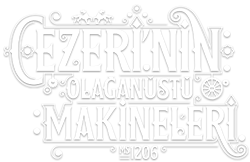During the time Jazar, mechanics gained lots of innovations, and useful solutions, which provided a much more solid footing for the modern mechanics that would follow it. Other than the elements of humor, culture, and art in addition to functionality during Jazari’s time, mechanics gained some solidity that led mankind to a later industrial revolution after him. The story of mechanics that started with an effort to survive, and then combined with art, now was moving into a whole new level. Mankind was conquering the world. Western Europe got richer when new continents were discovered, and modern thinking helped the science and art to move ahead. This wasn’t important only for the Western Europe, but the entire mankind to move to a new modern world.
Impressum of the Kitab al-Hiyal

The masterpiece that changed mechanics: Kitabal Al-Hial
AL-CÂMİ’ BAYN AL-‘ILM VA AL-‘ AMÂL AL-NÂFİ’ Fİ SINÂA’T AL-HIYAL
The Book of Knowledge of Ingenious Mechanical Devices
Badīʿ az-Zaman Abu l-ʿIzz ibn Ismāʿīl ibn ar-Razāz al-Jazari
With its shortened title, Kitab al-Hiyal, this engineering masterpiece was penned by the chief engineer of the court upon the request of Sultan Nāsir al-Dīn Mahmud in 1206, at Diyarbakir Artuqid Palace. Within the book, there are 50 devices and machines categorized in 6 groups. As George Sarton mentions in his classical masterpiece Introduction to the History of Science (1927), “Jazari’s book is the most detailed one among its peers, and it can be seen as the zenith of Muslim achievements in its line of work.” Jazari’s book is so famous in science and technology history that in his book Leonardo’s Lost Robots (2006), Mark Elling Rosheim claims that after the collapse of Roman Empire, Hellenistic water clocks and automata traditions were able to be transferred to the future generations by only Kitab al-Hiyal, and that even some of the mechanisms that Leonardo da Vinci was able to use were moved to Europe. While we don’t have the original version of Kitab al-Hiyal, 15 manuscripts – the oldest dates back to first half of 1200’s – and 2 translated copies of the book are preserved in various libraries all around the world.
Arabic Manuscripts
1. Istanbul (1354), Hagia Sophia Library, No 3606
2. Istanbul (1206), Topkapi Palace, No 3472
3. Istanbul (1273), Topkapi Palace, No 414
4. Istanbul (Early Period), Topkapi Palace, No 3461
5. Istanbul (1315), (sold in London) Broken copy
6. Istanbul (1459), Topkapi Palace, No 3350
7. Oxford (1486), Bodleian Library, No Graves 27
8. Oxford (17th Century), Bodleian Library, No Frazer 186
9. Leiden (1561), Leiden University Library, No Or. 656
10. Leiden (undated), Leiden University Library, Imperfect, No Or. 117
11. Dublin (1329), Chester Beatty Library, No 4187
12. Paris (1485), National Library, No Arabe 2477
13. Paris (17th Century), National Library, No Arabe 5101
14. Petersburg (Late Period), Narodov Azii Institute
15. Berlin (undated)
Translated Manuscripts
1. Persian, Paris (1874), National Library, No Pers 1145 and 1145a
2. Ottoman Turkish, Istanbul (16th Century), National Library, No 227
Followers of Jazari’s Footsteps
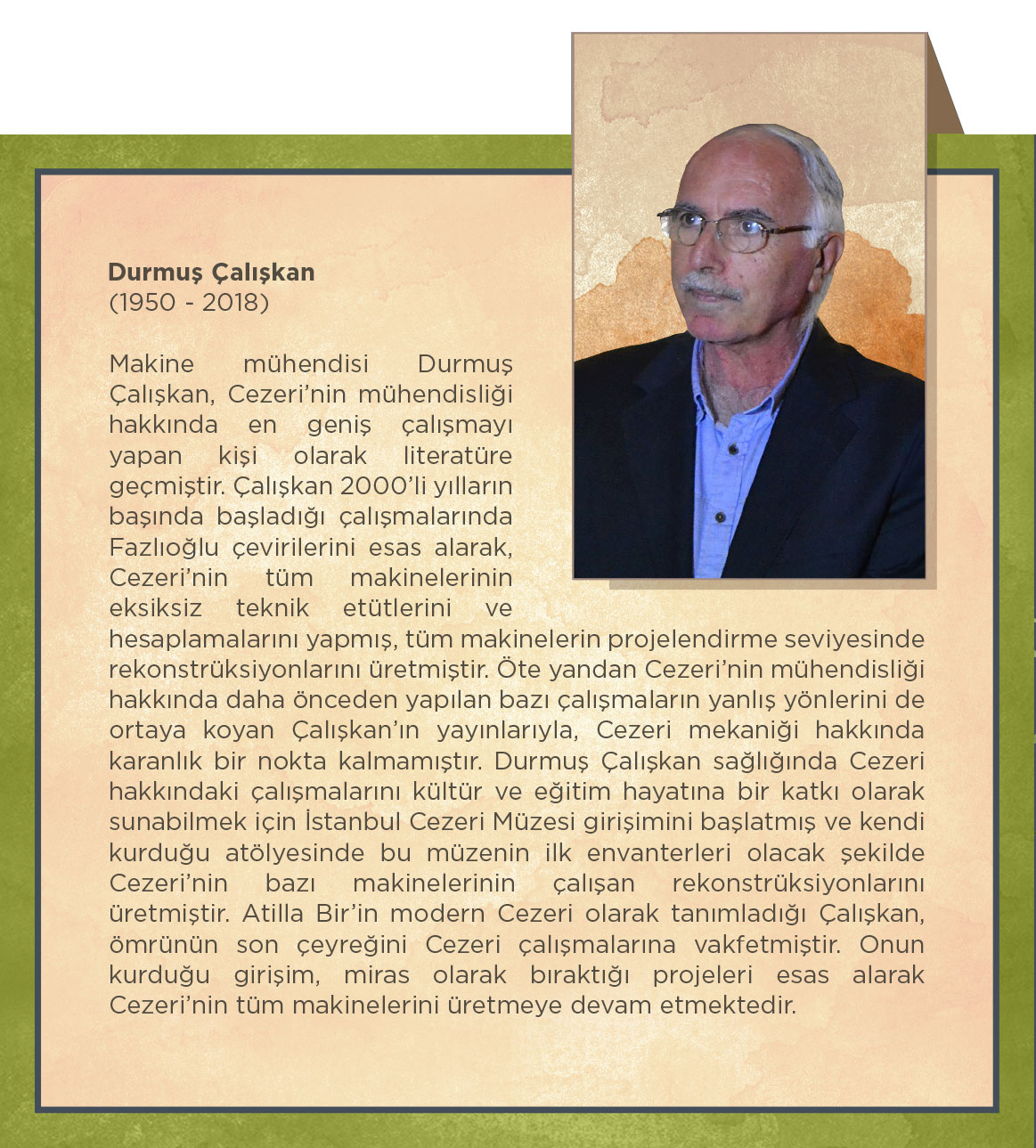
Jazari inspired lots of engineers in his own time, helping the mechanics to move to a new phase. Even if we couldn’t see his influence that transcends centuries beyond himself in the books written afterwards, we can see them all in the machines and mechanisms created or used later on. In late 19th and early 20th centuries when modern history became an academic work, many engineering and science historians worked so hard and wrote countless books to understand his works and enlighten his legacy.
Prof. Dr. Eilhard Wiedemann (1852-1928)
Prof. Wiedemann was the first to appreciate Jazari’s genius, and to introduce him to the wider world. In the beginning of last century, as he did in many subjects of Islamic science history, he wrote lots of articles about the mechanisms and machines in Jazari’s book with the help of his assistant and engineer F. Hauser.
Bernard Carra de Vaux (1867-1953)
French science historian Vaux wrote with so much praise about Jazari’s book and machines in the second volume of his monumental masterpiece of five volumes, Les Peunseur de L’islam.
Ibrahim Hakki Konyali (1896-1984)
In Turkey, the famous historian Ibrahim Hakki Konyali (1896-1984) was the first to mention about this work in the articles he wrote for the magazines Tarih Hazinesi (1951), and later on for Kara Amid (1972), and also mentioned about Wiedemann’s works about Jazari.
Dr. Toygar Akman (1927-2011)
Young people in Turkey came to know Jazari especially by the articles Akman wrote for the Bilim ve Teknik magazine between 1973 and 1976. Akman’s articles left a powerful impression on the young readers.
Prof. Dr. Donald R. Hill (1922-1994)
The complete Arabic text of Jazari’s classic reached to the readers for the first time when Donald R. Hill translated it to English in 1974. In addition to his translation work, Hill also did some technical studies on some of Jazari’s machines, and published his observations as notes in his book. Also, he joined the reconstruction work of Monumental Water Clock for London Science Museum.
Prof. Dr. Kazim Cecen (1919-1997)
Prof. Dr. Kazim Cecen followed these initiatives with his declaration during a congress held at Istanbul Technical University (1981), leading to a project for building Peacock Clock fully functional by his people at the university, and having it exhibited during this congress, and supporting these works with his other conferences and articles.
Prof. Dr. Atilla Bir
Prof. Dr. Atilla Bir, published many articles especially in the magazine Otomasyon with Senior Engineer Mahmut Kayral as co-author, and talked about these machines during some other congresses. Thus, these scientists were among the ones who published and talked about Jazari in Turkey.
Prof. Saadettin Okten
Prof. Sadettin Okten added the item titled “Jazari” to the Islam Ansiklopedisi (Encyclopedia of Islam), helping to clear the historical disinformation about Jazari at academic level.
Prof. Dr. Sevim Tekeli, Prof. Dr. Melek Dosay, Prof. Dr. Yavuz Unat
Jazari’s book was translated to Turkish for the first time in 2002 by Tekeli, Dosay, and Unat.
Prof. Dr. Fuat Sezgin
Turkish scientist Prof. Dr. Fuat Sezgin, one of the most productive writers about History of Islamic Science, introduced some of the machines designed by Jazari in his work Islamda Bilim ve Teknik (Science and Technology in Islam) published by Metropolitan Municipality of Istanbul. Models of some of these devices are exhibited at the History of Islamic Science and Technology Museum, which was again his creation.
Prof. Dr. Ihsan Fazlioglu – Sukran Fazlioglu
Jazari’s book was translated to Turkish for the second time by Ihsan & Sukran Fazlioglu, and in addition to the technical works of Durmus Caliskan, this translation was published in 2015 with the title Jazari’s Olaganustu Makineleri (Extraordinary Machines of Jazari).
Durmus Caliskan (1950-2018)
Mechanic engineer Durmus Caliskan was recorded in literature as the person who made the most comprehensive work on Jazari’s engineering. In his work he started in early 2000’s, Caliskan took Fazlioglus’ translation as reference, and made all the complete technical examinations and calculations, and reconstructed all of his machines as projects. On the other hand, he also pointed at some mistakes in the previous works about Jazari, and left nothing in the dark. Durmus Caliskan started the first attempts for the Istanbul Jazari Museum venture to contribute to the culture and education, building fully functional reconstructions of some of Jazari’s machines in his own workshop. Caliskan, who was described as modern Jazari by Atilla Bir, dedicated the last quarter of his life to Jazari’s works. This venture he started continues producing all he machines of Jazari based on the projects Caliskan left behind as his legacy.
Jazari’s Influence
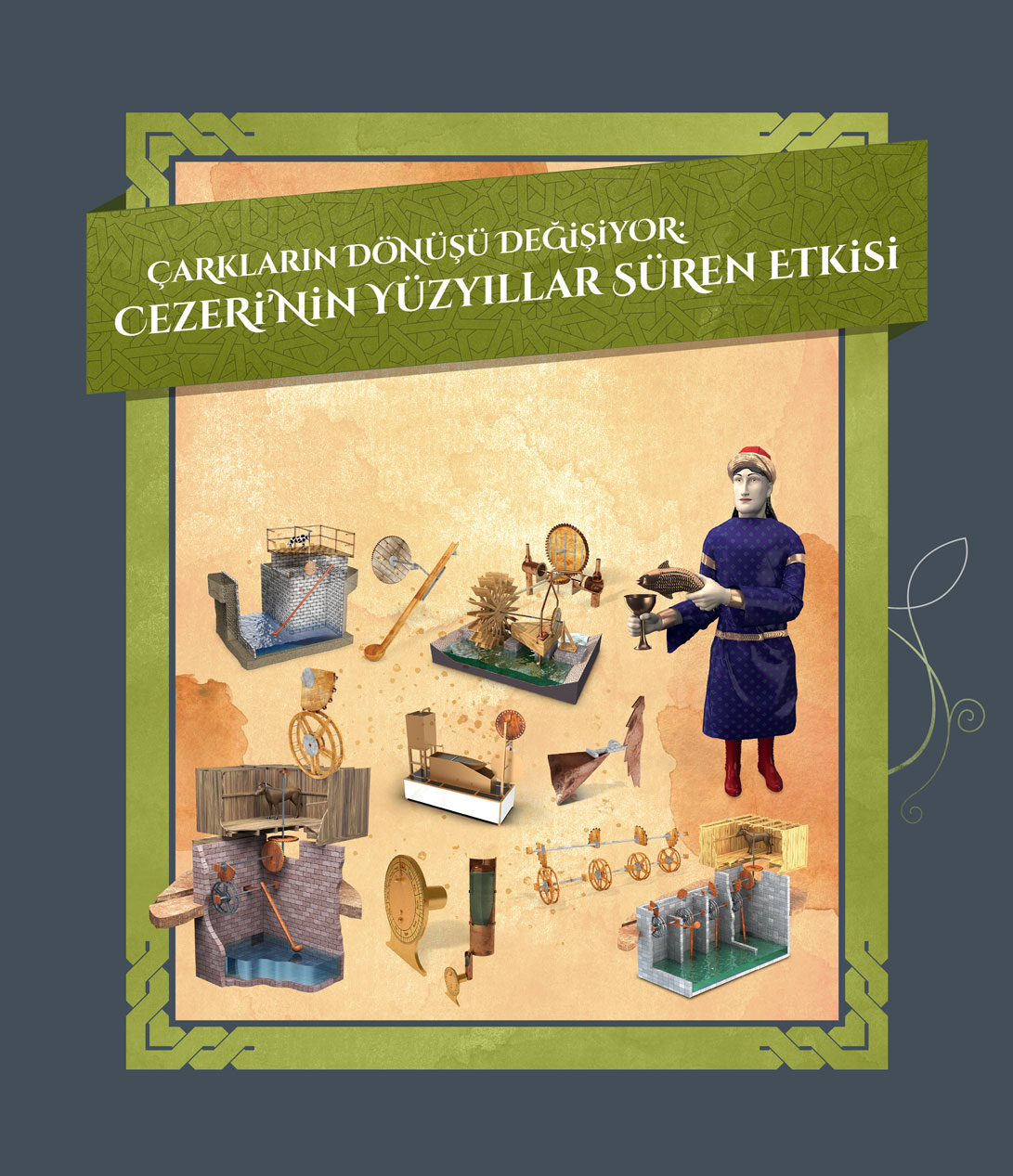
Gears Change Direction: Jazari’s Influence over the Centuries
As Jazari’s great legacy in mechanics was used by the Ottomans, it was also welcomed widely in all around the world. We know that many of the mechanic inventions like crankshaft that is the essentials of modern mechanics were used in Jazari’s machines 300 years before they were used in Europe. In his book Distinguished Figures in Mechanism and Machine Science (2010), Marco Ceccarelli talks about how the techniques and approaches Jazari used to build his extraordinary machines left an amazing inflence over the design of modern machines. It’s emphasized in many sources that the knowledge and techniques produced in East during the Crusades, especially in Jazari’s time, were transferred to Europe by soldiers, travelers, and politicians. Again, as Michela Cigola mentions in his conference text titled “The Influence of Ancient Greek Knowledge over the Islamic Science in Middle Ages,” (2006) while Jazari’s fully functional machines reached a wide audience in the region during his own time, it was also one of the most important elements of knowledge transfer between the East and West through Spain where the Christians and Muslims lived together for eight hundred years. In the book A Brief Illustrated History of Machines and Mechanics by Emilio Bautista Paz, Marco Ceccarelli, Javier Echávarri Otero, and José Luis Muñoz Sanz, (2010) Jazari’s influence that went beyond hundreds of years was shown quite clearly:
Jazari was the most extraordinary mechanic engineer of his time. His influence that reaches us is the greatest evidence to this claim; also, this influence is not limited only by Islamic world. Many of the machines, mechanisms, or techniques that were seen in his book for the first time became an essential part of European mechanic engineering later on. Among Jazari’s contributions to the designs, we can give examples like double action pumps with sucking pistons, sensitive calibration of the holes, wooden lamination treatments against friction problems, static wheel balance, and paper models for design tests.
When the project and production principles in Jazari’s book Kitab al-Hiyal are carefully examined, it’s easy to see the expressions of modern mecanic engineering. With that, it can be clearly understood that not only with his inventions, but also with his philosophy regarding building and use of machines, Jazari was a genius with an influence that went beyond centuries.
Engineering in Ottomans Poster

ENGINEERS OF THE SULTAN: ENGINEERING IN OTTOMANS
Copying Jazari’s engineering both in applications and translations, Ottomans continued the mighty legacy of Islamic engineering. In addition to that, they created their own manuscripts to support and develop Islamic engineering even more.
FComing to Anatolia during the time of Mehmed the Conqueror, al-Kirmanī translates some part of Jazari’s Al-câmi‘ beyn al-‘ilm ve al-‘amel an-nâfi’ fi sınâa’ti’l-hiyel to Persian, and presented it to Mehmed the Conqueror with the title Bedâyi al-amel fî sanâyi’l-hiyal. Al-Kirmanī examined the clocks in the first section, a musical tool in second, a method that raises water without piles and human effort in third, and a sundial, a hourglass, and kiblanoumah (a compass that shows the direction of kiblah) in fourth.
Another important book on engineering that was written during the time of the Conqueror was the work by famous Turkish mathematician and astronomer Ali Kuscu with the title At-tezkîrah fî âlâtī’r-ruhâniyyah (A Dissertation over Atuomatic Machines). Unfortunately, this book that was in Persian didn’t reach our time. Taqi al-Din Muhammad ibn Ma'ruf ash-Shami al-Asadi wrote about this work in his book about mechanical clocks.
Taqi al-Din Muhammad ibn Ma'ruf ash-Shami al-Asadi, the great astronomer and the founder of Istanbul Observatory wrote his book At-turuku’s-saniyyah fî’l-âlâti’r-ruhânniyah (Divine Methods for the Making of Automatic Devices) in 1551. In this book, which was the latest and most advanced work on Islamic engineering, lots of innovative mechanisms were introduced, such as, water pumps that powered by animals and gears, water pumps with six cylinders, rotating platforms powered by steam, geared crane mechanism that lifts 1.5 ton weight with 1.5 kg force, and a pulley block of 16 gears. His most important work is the steam turbine that rotates by the hot steam. This peerless system was the first example of steam turbines that would be seen in Europe much later. The first steam turbine we see in Europe was the mortar and pestle mechanism that was powered by steam, which was built in 1628 by the Italian engineer Giovanni Branca.
Another important book on engineering by Taqi al-Din al-Asadi was Al-kevâkibu’d-durriyyah fî vaz’i’l-benkâmâti’d-devriyyah (The Brightest Stars Regarding the Making of Mechanical Clocks). He explained the mechanical clocks and their principles in this book. It is one of the most important works about mechanical clocks ever written by that time both in Europe and Islamic world. This book, which pocket watches, table clocks, wall clocks, and astronomical observation clocks were explained, was highly important also because he saw the clocks as an astronomic observation tool – these clocks also showed the minutes and seconds. The clocks that show minutes and seconds showed up in Europe much later in 1670.
Towards the end of 16th Century, the last great advance period of Islam civilization, Jazari’s books was translated to Turkish with the title Tercumah-i Hiyal. This work that was presented to Sultan Murad III (reigned 1575-1595) was important because it helped Turkish language to come forward as a scientific language, and also made engineering works popular among the Ottomans. Translator said that he aimed to “dress the book in Turkish clothing, and make it more visible.” Therefore, the translation of Jazari’s book Turkish shows the Ottoman engineers were highly interested in mechanic science. Water clocks, drink automata, tricky cups, water tanks with fountains, water raising mechanisms, and various measuring tools were explained in the book.
Conquest of Vienna II, which failed in 1683, had crushing effects on Ottoman Empire that was peerless in military arena until the end of 17th Century. After the defeats that came one after another, Ottoman authorities realized their military power and techniques were inadequate, and began to observe new militaristic developments in Europe. Many works that were published in Europe have been translated to Turkish since the time of Sultan Ahmed III (reigned 1703-1730), and imported some military experts from Europe. With the help of experts like Comte de Bonneval (Humbaraci Ahmed Pasha, 1675-1747) and François Baron de Tott (1733-1793), advanced institutes like Humbaraci Military School and Chamber of Handassah were established. At first, the books translated from European languages were taught in these schools, and then Ottoman military experts wrote their own textbooks.
Humbaraci Military School second president Bayramoglu Ali Aga wrote his book Ummu al-Gazâ in 18th Century. It was a unique book that told about the production of explosive balls named humbara by Ottomans, how the special cannons were built, range calculation methods, castle sieges, and use of these weapons for defense purposes. With an wide military experience under his belt, Bayramoglu Ali Aga describes some very unique and machines like six barrel mortars, wheeled mortars, barrel humbara, burning rockets named tayyâr/tayyârât, hooked and wheeled ladders to dig trenches, slog shooting mortars, 90 degree miters for mortars, and a French style “grande pump” in his book. It was one of the most important works about Ottoman military technology in 18th Century.
Between 1734-1735, the young soldiers were trained at Humbaraci Military School that was founded with the efforts of Humbaraci Ahmed Pasha, also mathematic, geometry, trigonometry, and ballistics were taught. Despite the curriculum was based on the books that were brought from France, Turkish translations of this works and original Turkish books replaced them later on. One of these books was Fenn-i Humbara ve San’ayi’-I Âteş-bâzî (Humbara Techniques and Explosive Production) by Mustafa ibn Ibrahim, who was one of the school teachers. This book that began with the history of explosives, and described the cannons, humbara balances, range measurements, mortars, production of explosive balls, angle measurement, geometry, gunpowder, and trench digging. With many figures and drawings of tools, schematics, and weaponry, this book was one of the most important works about armament production in 18th Century.
Taqi al-Dīn’s Clock

This clock by Taqi al-Dīn was reconstructed by miniature machine and replicate builder Ersan Dogan based on the technical data and directives given in the book “Clock Making in 16th Century Ottoman Culture and Taqi al-Dīn’s ‘The brightest stars regarding mechanical clock construction’” translated by Prof. Sevim Tekeli, and published by Department of Culture. The gear notch numbers and ratios were given completely by Taqi al-Dīn – main body and dial were made based on his directives again. The material used was chosen accordingly in the material processing techniques and materials of the period. In this clock that works with two different weights, one weight works the clock, and the other hourly alarm. This is an observation clock, which shows the appearance of moon in the sky, minutes, days of the week, and normal time. Since it rings as many as the hour it notifies, it allows the master to focus on his observation work at hand with no distractions. This reconstructed model is the first working one of its kind.
Istanbul Observatory Diorama
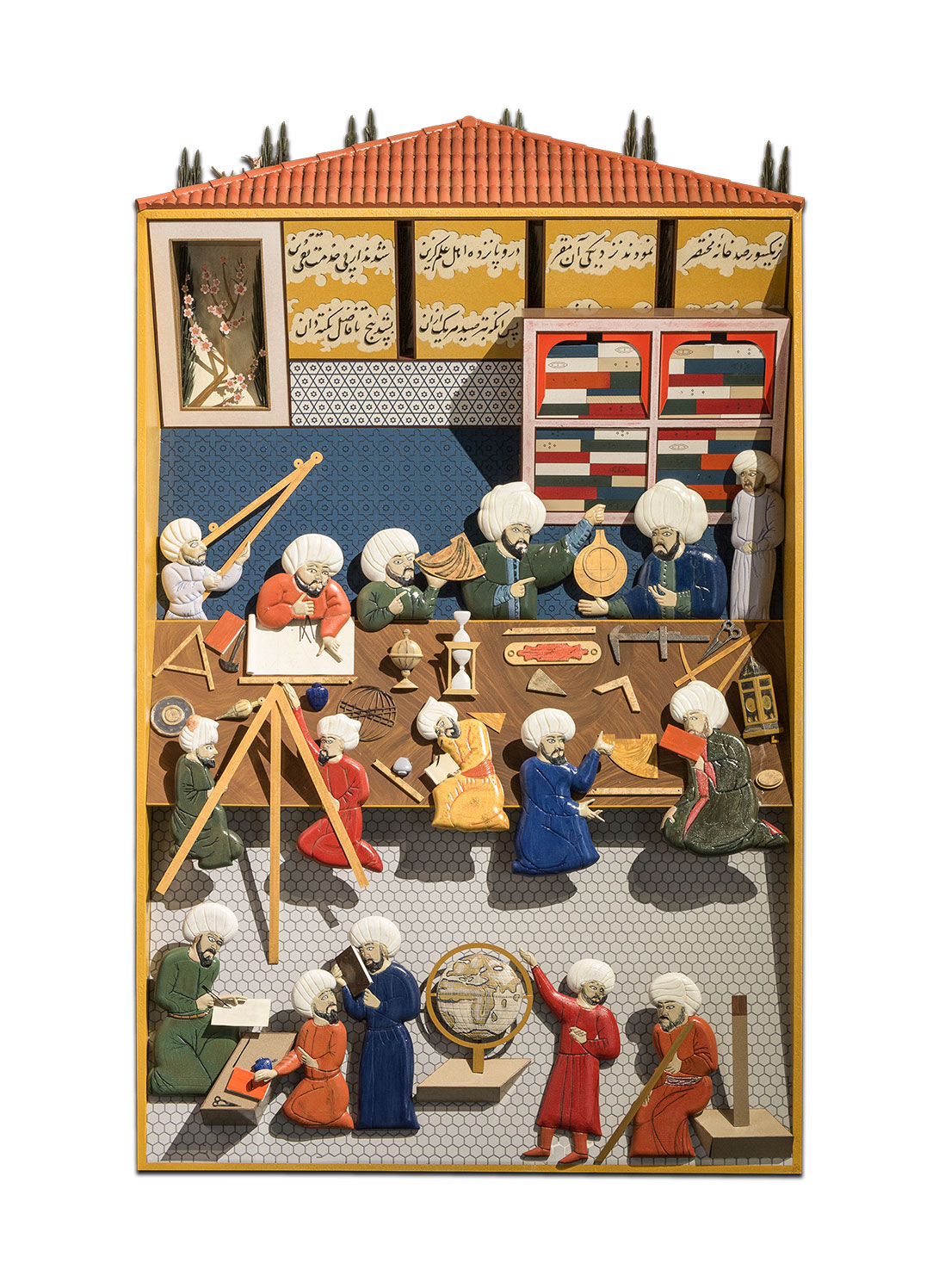
We see the story of Taqi al-Dīn in Istanbul Observatory, who was one of the most important scientists of Ottoman Empire. This story is not only Taqi al-Dīn’s, but a tragic story of us all. Istanbul Observatory was one of the most prominent research centers of its time with its superior technology and devices. Taqi al-Dīn’s aim was to do the best observations, examining the astronomy models. The observations that started in the West led to the discovery of Sun centered universal model. The paths that could lead Ottoman to the top of new scientific world would get stuck in the years to come, but we hit the first blow on our own. We destroyed the most amazing observatory of the world with our own cannon fire. In this work, you see the diorama of a miniature that is left from Istanbul Observatory, which is the only document survived today. Taqi al-Dīn is working in the observatory with the top notch technology devices and his best astronomers to understand the skies, and their amazing effort is stuck in the two dimensional space of the miniature. The heroes in this image are pictured with a limited depth as if they are trying to go beyond the limitations of a two dimensional world. However, the only thing we are left with here is a very deep sorrow, and a very important lesson for the future.
The Gates to the Heavens in Ottomans: Istanbul Observatory
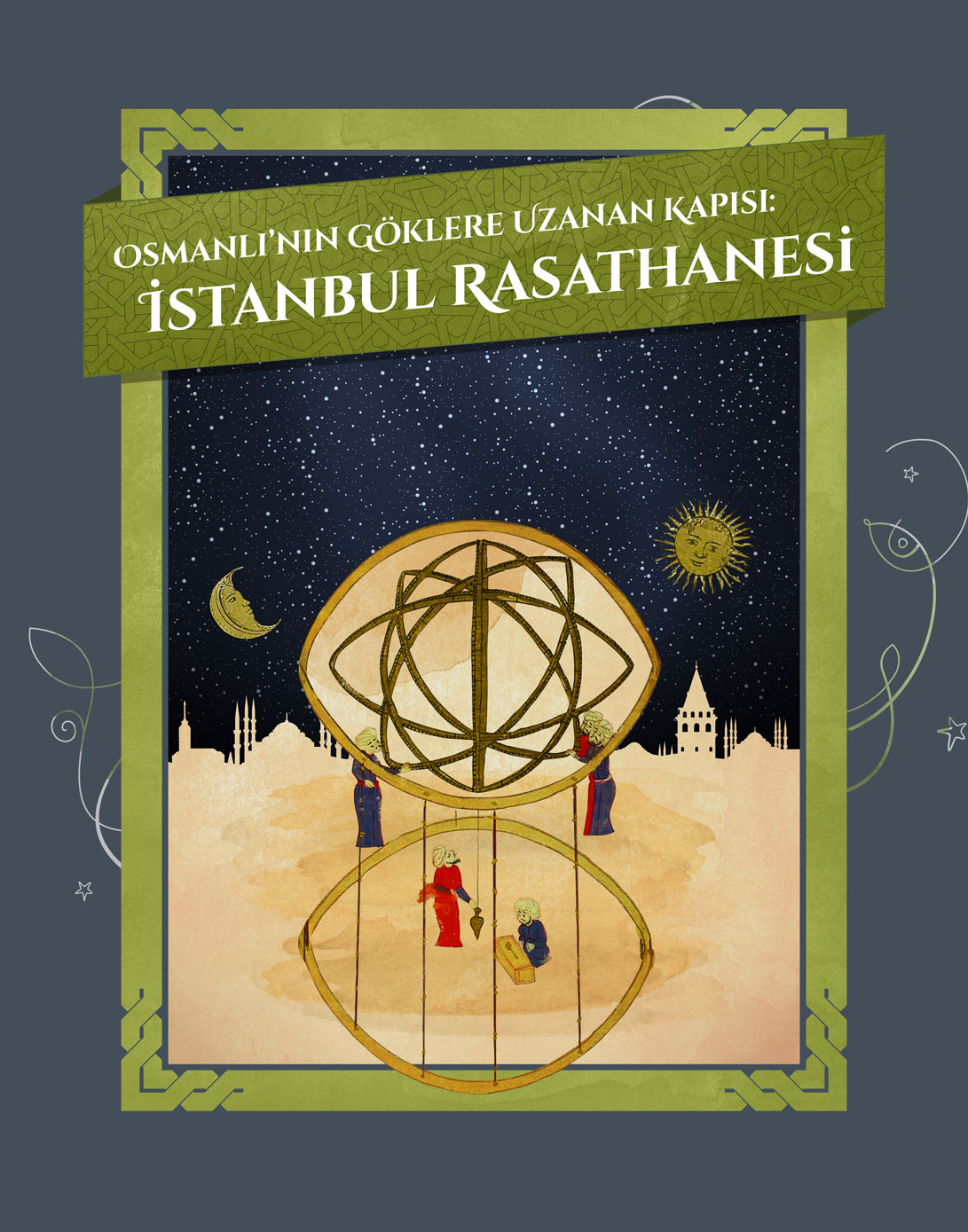
The Ottoman Empire, bringing all the political, economical, cultural, and scientific knowledge together in Istanbul, boasted research systems that were supported by Taqi al-Dīn, an amazing inventor and scientist, who moved to Istanbul in 1570, starting such an expensive endeavor that required high level of master skills. By Sultan Murad III, Taqi al-Dīn was appointed to build an observatory over Tophane in 1575. After the construction work that continued for two years, the first observatory of Ottoman history started working at full capacity in 1577. The observatory where 15 astronomers worked moved the observation efforts to the new levels that Taqi al-Dīn continued with his own resources since 1573.
As the scientific devices like telescope became a standard in the field before 19th Century, heavenly bodies were guides for the mankind. We understood the universe, and measured the time by them. The systematical observation traditions that began in Mesopotamia five thousand years ago were empowered and improved in Indian, Persian, and Greek cultures, leading to the highly sophisticated observations with superior technology in Islamic culture. The Maragheh Observatory with Nasir al-din et-Tūsī at the helm in 13th Century, and Semarkand Observatory built by Ulug Beg in 15th Century were the research centers where Islamic culture made itself felt most.
Istanbul Observatory became an arena where Taqi al-Dīn performed his skills in mechanics, optics, and astronomy. In addition to many other devices, he designed a very sensitive astronomical clock that was used for heavenly observations, and coming up with highly sensitive systems with gigantic dimensions. The observatory was used for highly sophisticated observation efforts until early 1580, and updated the knowledge regarding astronomy. Moreover, the devices and tools used in this observatory were very similar to the ones used in Uraniborg Observatory built in 1576, Denmark byt Kepler’s mentor Tycho Brahe. This similarity that is remarkable for many experts in the field even today shows the level of knowledge in Ottomans. However, the observatory became a topic of arguments within the court, and by the decree of Sultan Murad III, it was destroyed in 1580.
Mechanical Clocks in Europe
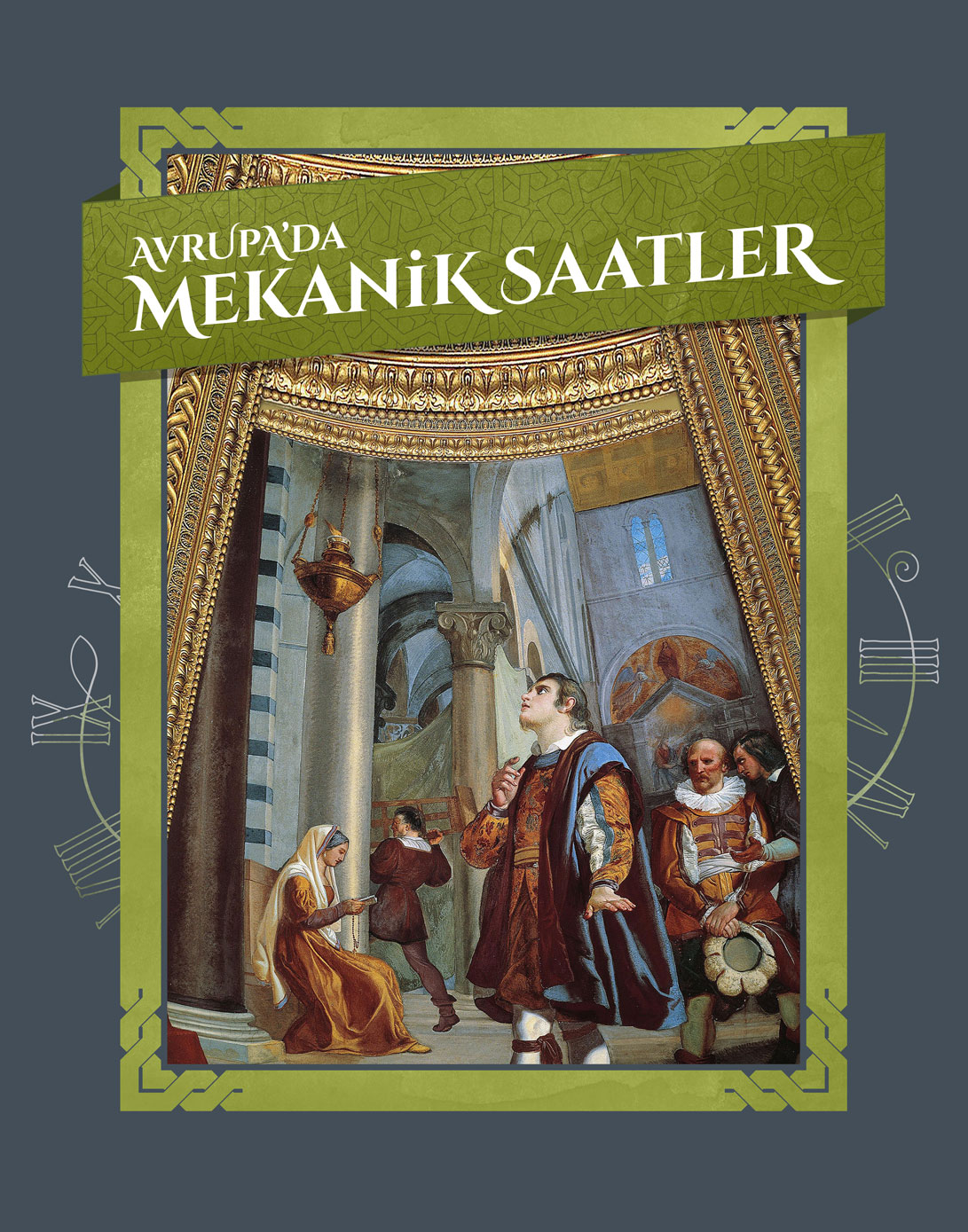
The oldest mechanical clocks in Europe were seen in France and England in 13th Century. They became quite common in 14th Century, especially in Germany and Italy. They work by weights, and have axe escapament-pendulum system. These clocks that were made in gigantic dimensions were mostly used in church and cathedral towers. The error percentage in these clocks is high, and they require regular adjustments.
As the commercial world progressed in Europe beginning from 15th Century, and with the invention of clocks made by finer skills, they needed to be smaller and portable. So, a German locksmith and keymaker, Peter Henlein, made the first portable clock in 16th Century, inventing the spiral spring in the clocks, instead of pendulum. This development made it possible for the creation of table and pocket clocks. These clocks had just hour hand, and minute hand wouldn’t be seen until 1670. However, Taqi al-Dīn talked about the clocks that could show both hours and minutes in his book about clocks, which he wrote in 1563.
The first person who pointed at the connection between regular physical movement and the flow of time was Galileo Galilei. Observing the pendulum movement of a chandelier in Pisa Cathedral, he discovered that despite the chandelier slowed down eventually, the pendulum movement was equal in in both ways. Galilei thought this principle could be used for the clocks, but such a clock was made only after his demise.
Dutch scientist Christiaan Huygens made the first pendulum clock in 1656. These clocks that were based on the principle of pendulum equality had an error percentage below one minute a day. Huygens pulled this error margin below 10 seconds a day later on. Robert Hooke in England developed the spring balace wheel in 1675 along with Huygens, despite they worked unaware of each other. Huygens made a pocket watch based on this mechanism, and gained a patent in the same year. Despite the early period clock makers rose in Germany, Netherlands, England, Italy, and France, Swiss clock makers became superior beginning from 18th Century. These inventors travelled all around Europe, and the local industrialists paved the way for great Swiss clock maker companies that survived even today.
Western Mechanics in Middle Ages and Renaissance

Europe walked into a “dark” period with the collapse of Western Rome Empire. The material culture and technical skills in Europe between 5th and 11th centuries were far behind Islamic world, China, and India. However, the Europeans managed to come up superior from this dark period. The suitable rivers in Europe made it possible for horizontal and vertical mills to become common quickly. Also, copying from the Islamic world, the windmills were built where the water power didn’t exist. These mills were much simpler than the dams and irrigation systems made in Andalusia, and they required much less technical skills. Still, the vast knowledge taught the European artisans a lot.
As the production rose by the help of these mills, the urbanization and wealth rose in Europe beginning from 11th Century. Since the slavery wasn’t common as it was before, machinary and wealth won against the limited human power. The architects and engineers became important as the city builders. French architect-engineer Villard de Honnecourt (13th Century) told about the construction of churches in his famous Sketch Book with over 250 images, and described many mechanisms from the mills to automata, water powered saws and ballistas. All of this led to historical names like Leonardo in Europe, and Mimar Sinan among the Turks.
The urbanization brought the rise in the number and dimensions of the churches and cathedrals, which brought a rise in bell making, which developed as a trade. Metal processing and jewelry making became common with a rising sensitivity. The improvements in mechanical clock making since 14th Century brought the developments in fine trades. In 1447, a German jeweler Johann Gutenberg reinvented the printing press with screwed press, moving letters, and metal molds. The need for iron, copper, and spelter rose in civil and military arenas, requiring more depth in mining, which led to the need for powerful water pumps. In his book de Re Metallica, Georgius Agricola described the water pumps, cylinders, pistons, mills, chain transfer mechanisms, and gears in 1556. Jacques Besson, the court engineer for French King Charles IX, developed the first modern turning machine in 1579, and sensitive material processing became possible. The developments in material techniques, combined the high quality and fine skills, led to the creation of steam engines. Steam engines were the result of the search for a new energy source other than water and air. In Istanbul, Taqi al-Dīn described a shawarma machine that was powered by steam in his book Al-Turuq al-Samiyyah. The first person who wrote about the steam power in Europe, Italian engineer Giovanni Branca, introduced a steam powered mortar and pestle system. English nature philosopher and priest John Wilkins described a furnace that was powered by steam in his book Mathematical Magick dated in 1680. Dennis Papin described the first steam piston in 1680, and invented the steam pot. Thomas Newcomen made the first atmospherical pistoned steam machine in 1712. Scotch inventor and mechanics engineer James Watt improved Newcomen’s machine in 1776, making it more productive, and became the inventor of modern steam engine. The world was stepping into a new period that was called Industrial Age.
Leonardo da Vinci

Leonardo di ser Piero da Vinci or Vincili Leonardo (1452-1519) was an architect, engineer, inventor, mapper, geologer, anatomist, astronomer, bothanist, sculptor, musician, and painter… Shortly, an erudite with a thousand talents and skills… One of the greatest names in Renaissance, Leonardo da Vinci was trained by the famous painter and sculptor Andrea del Verrocchi. Thanks to Verrocchi’s special interest in human anatomy, he gained lots of knowledge about the human body, finding many opportunities to work with famous artists. He went to Milan in 1482, starting to work for Duke of Milan Sforza, serving for 17 years. In addition to the paintings and sculptures for the Duke, he also made buildings, weapons, machines, castles, and walls. On the other hand, he worked on the areas like nature, mechanics, geometry, flying machines, irrigation systems, and anatomy. He recorded all of his notes and sketches in his books. Doubtlessly, the most famous works of his were Mona Lisa and The Last Supper. However, his machines were also as special as his artistic masterpieces. While most of his designs were beyond his time so far that it rendered them impossible to make real, all these designs showed his genius. Leonardo used leverages, pulleys, gears, chains, cogwheels, rack gears, crankshafts, and bearings for many of his designs. On the other hand, it’s known that he cared for physical principles like momentum, centrifugal force, friction, and aerodynamics.
Leonardo wrote a letter to Ottoman Sultan Bayezid II in 1502, and claimed that he could build a bridge of 240 meter long between Galata and modern Eminonu over Golden Horn that could be high enough to allow boats to pass under. However, Sultan Bayezid II didn’t approve the building of such a bridge that was highly difficult with the technology of the period.
Pendulum Working System
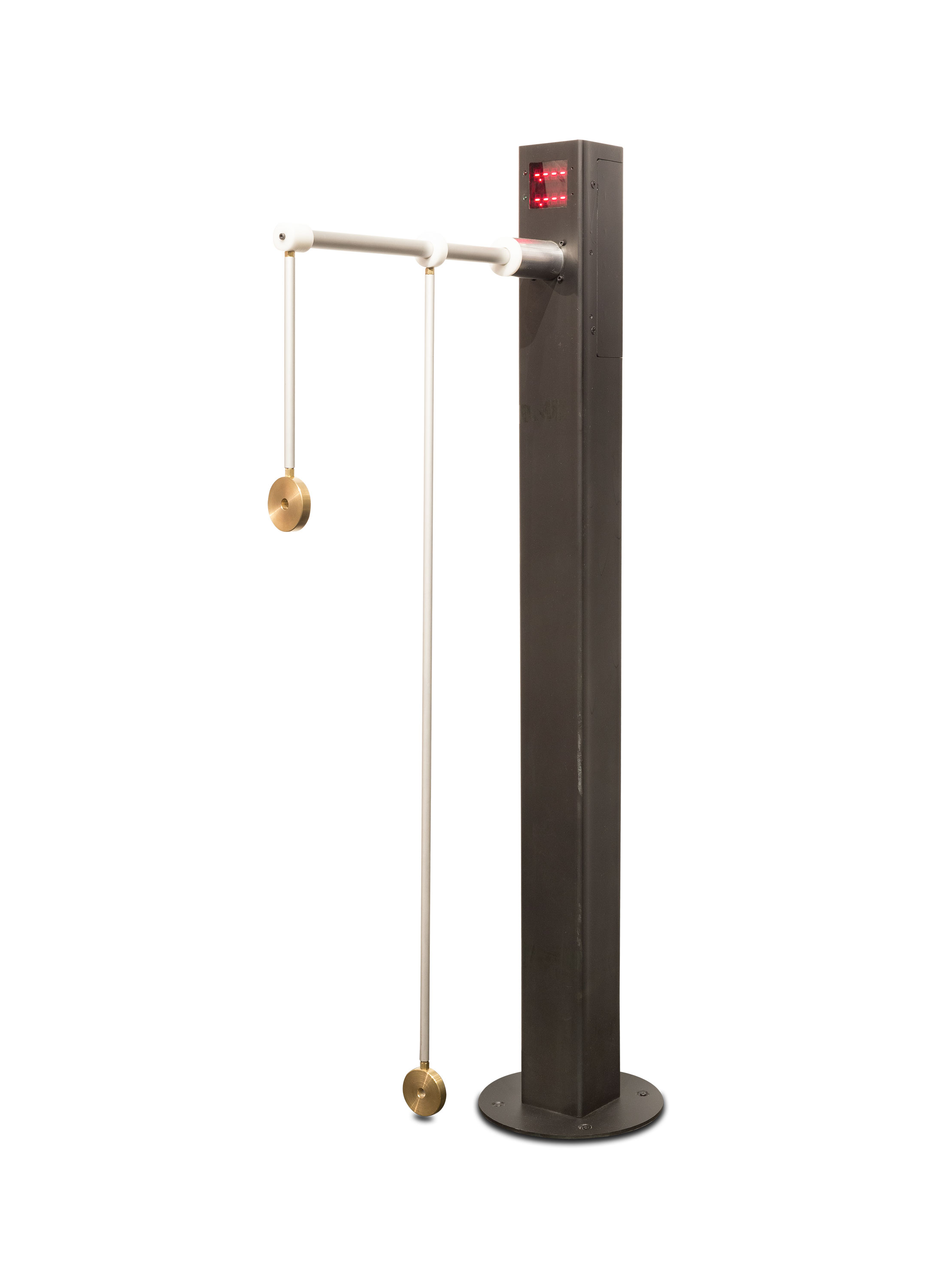
The pendulum, discovered by Galileo, is the free swinging movement of a weight tied to a wheel. While the pendulum is in balance, if it’s moved to some angle, it creates a back-force to go back to its balanced position, which causes a back and forth movement around this balanced position. One leftward and one rightward movement of a pendulum is called period. The pendulum time of a simple gravity pendulum is based on its length, gravity force, and the maximum angle it gains during the movement. It’s also independent from the mass of the sphere.
Pendulum clock working principle:
These are commonly used in pendulum clocks:
a. A wooden or metal stick
b. A flat weight at the end to minimize the air effect
c. A bolt to hold the weight
d. A low friction wheel or a spring to make pendulum movement easy
e. An arm to limit the pendulum movement
f. A channel where the pendulum stick can move
g. Also the main gear that is connected to the dial moves with the pendulum’s movement.
h. To make and limit the rotation in one direction, a system called escapement is used.
The Winder Galileo Pendulum
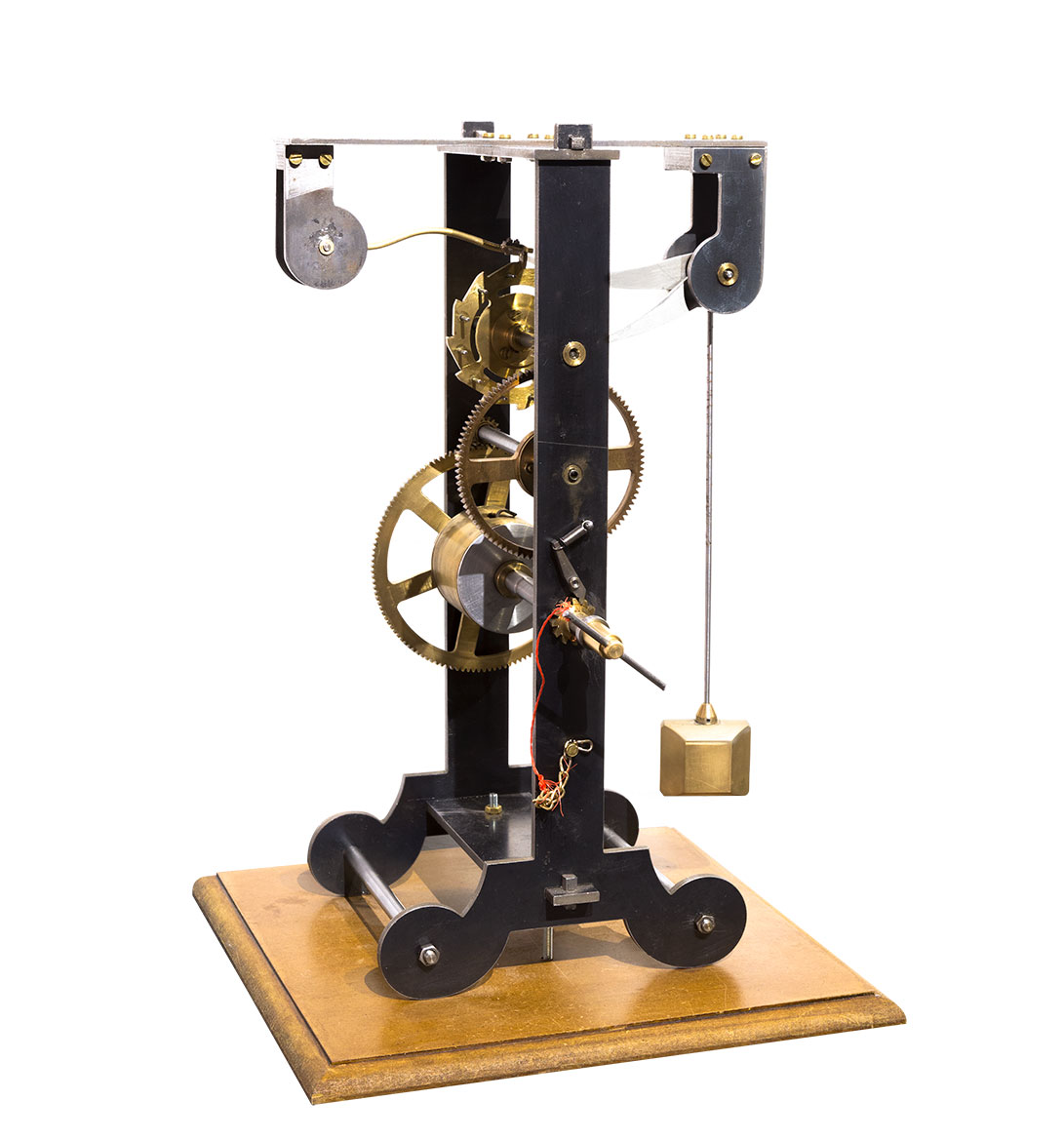
Differently than mechanical clocks with weights, a spring or winder provides the rotation for the main gear. The invention of the winder led to the portable small clocks that didn’t need weights.
The Weighted Galileo Pendulum
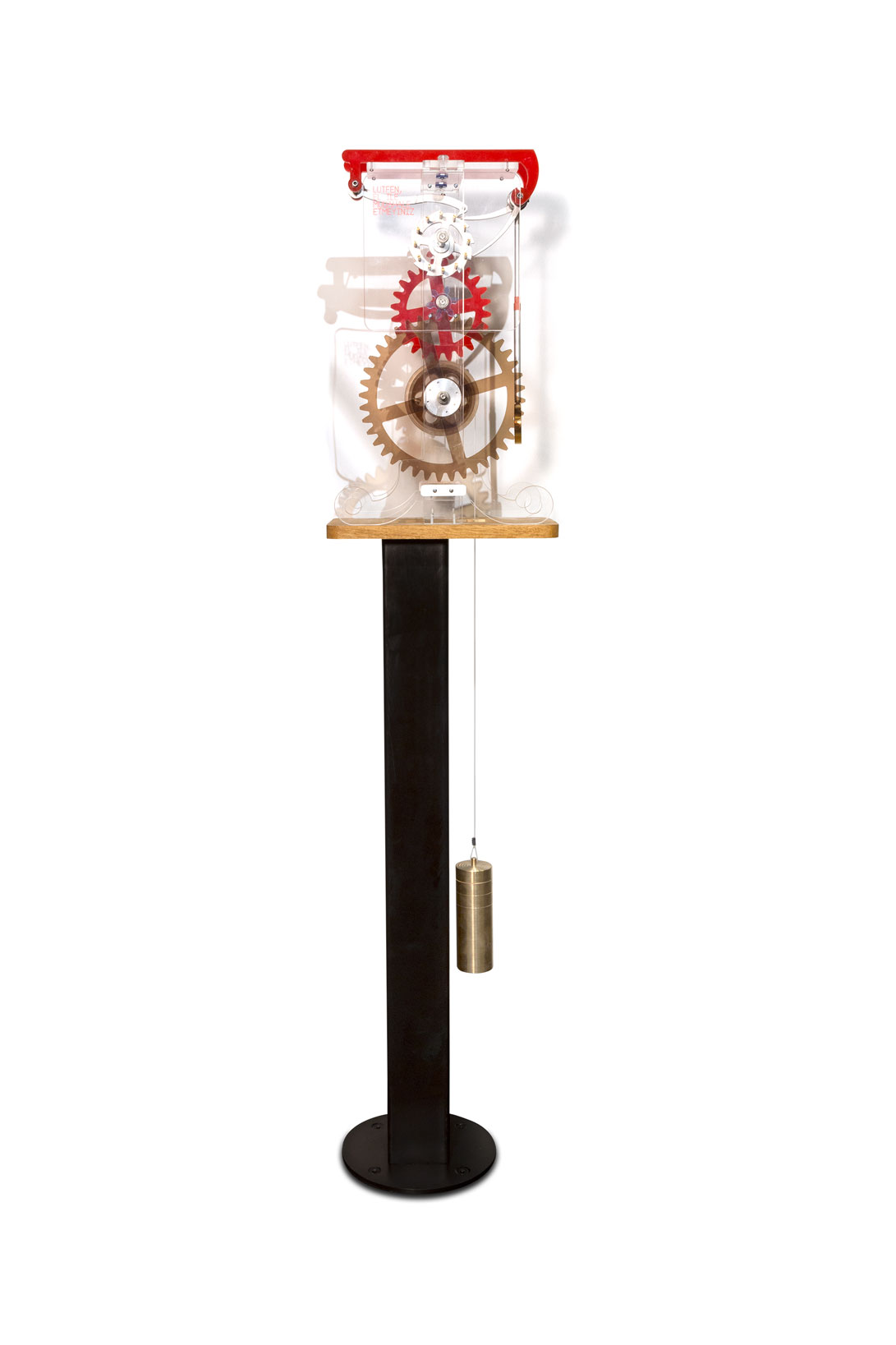
With the discovery of pendulums by Galileo, the mechanical clocks were made possible. A gear system was needed for pendulum clocks could be used for time measurement. And also a force should be applied to work these gear systems. This brought the creation of two kinds of mechanisms:
Weighted Mechanical Clocks: These mechanical clocks work based on the principle of gear systems work in harmony with a specific ratio. These are the main parts of such a clock:
- As a power of source, some weight at the end of a chain or cord that rotates a main gear.
- Pendulum – the factor that measures the time with a stick.
- A gear that transfers force and speed to a main gear at a specific ratio.
- The escapement that enables a gear to move one notch at a time, and keeps the continuum of pendulum movement.
- The clock dial that shows how often the escapement rotates and – thus – measures the time.
Turkish Mechanical Clocks
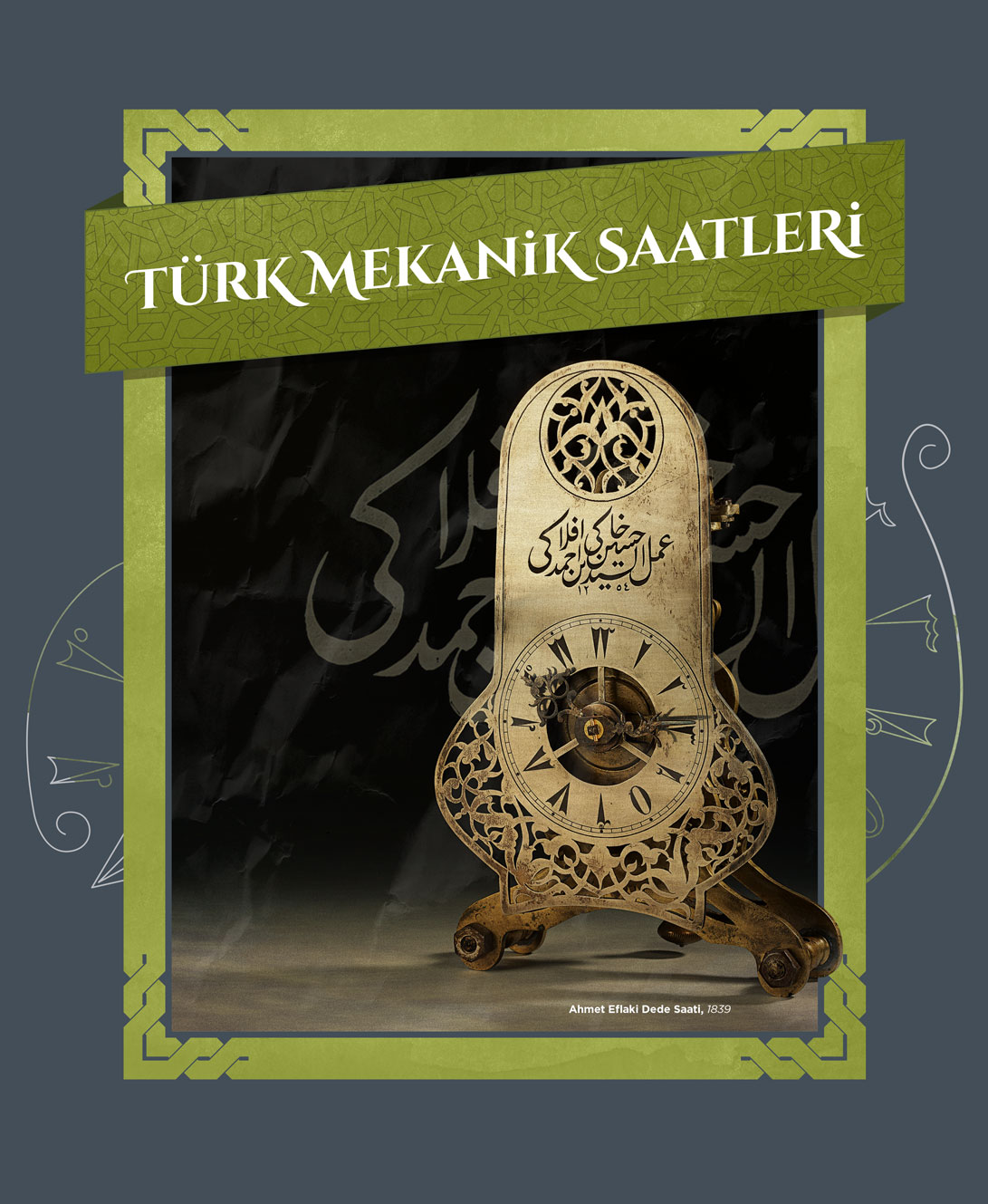
The Ottoman culture came to know the mechanical clocks in 1477, when Sultan Mehmed the Conqueror asked Venetia for a “glass master, clock master, and painter.” It’s not known if this master came or not. As a king interested in science and technology, the Conqueror probably saw the mechanical clocks that were brought by the European scientists after the conquest of Istanbul. Sultan Bayezid II, following his father’s footsteps, brought a mechanical clock from Europe to Istanbul. Mesmerized by the clock, the Sultan orders a master to be found, but there is none in Istanbul. So the clock is sent to Khorassan. Engineer Hafiz Abu Naeem Isfahani makes a similar clock, and sends it to the court. This is the first clock known to have arrived in the Ottoman court.
16th Century was the peak of Ottoman Empire. Among the gifts brought by European ambassadors to gain the Sultan’s favor, there were also mechanical clocks. So much that the ambassadors competed each other to present the most expensive clock. In effect, Ottoman court became a gallery that boasted the most beautiful European clocks of the time. Taqi al-Dīn, the most prominent astronomer and the founder of Istanbul Observatory, saw Sadrazam Semiz Ali Pasha’s (ten. 1561-1565) clock collection, and examined all of them, ending up with his most famous book The Brightest Stars Regarding Mechanical Clock Making. Taqi al-Dīn informs us in his book that these clocks were Dutch, Hungarian, French, and German made, in addition to that he examined these clocks, studying the works of other non-Muslim inventors and engineers, who also worked on clocks, and grasped the topic completely. Taqi al-Dīn described a wall clock, a desk clock, a pocket clock, and the astronomical clocks in his book, in addition to his own designs, and introduced the clocks that showed minutes and seconds as a first in engineering history.
As the number of these gift clocks rose, professional clock masters were needed for their maintenance. Thus, the European clock masters who were appointed for this task eventually remained in Istanbul. At the end of 16th Century, a head clocker and clock-watcher were appointed in the court. Also there were “Frankish clockmakers” in bazaars. These masters taught their trade to the Turks eventually, and clockmaking became common among the Ottomans, too. In Surname-i Humayun that tells about Prince Mehmed’s, son of Sultan Murad III, circumcision celebrations that lasted 52 days in 1582, the clockmakers are mentioned to have a procession.
Beginning from 17th Century, the mechanical clocks became a very important part of the social and business life in Europe, turning the clockmaking into some important profession. The European clockmakers who came to powerful and great Ottoman Empire in the hope for a bright future gathered around Galata, transferring European style clocks to Istanbul, creating new traditions of clockmaking, like Istanbulkari, or Galatakari. The clocks made in Istanbul were as flawless in aesthetics and techniques as European ones. The only difference was the numbers on the dial were “Turkish” and the decorations were in accordance with Turkish-Islam culture.
In 18th Century, the clock became an indispensable part of Ottoman lifesytle. French, English, and Swiss clocks became very common. The daily life was based on clocks. On the other hand, as the clockmaking became cheaper in Europe, lots of European clocks were imported to Istanbul. Galata became a center for European clock trade, which boasted lots of repairers.
Despite the clockmaking couldn’t become a commercial production in 19th Century Ottoman culture, the great artisans kept producing. Especially Dervish clockmakers made their greatest clock works during the time of Sultan Selim III, and Sultan Mahmud II. The greatest masters during this period, which was marked by a clock model that showed its interior and exterior structure, and called as “Skeleton Clock,” As-Sayyid al-Haj Durri, Ahmed Gulsheni, Mehmed Shukru, Mehmed Muhsin, Osman Nuri, Sulayman Leziz, Ahmed Eflaki Dede, and his son As-Sayyid Husayyin Haki. The most famous among all was Ahmed Eflaki, who was also known as “The Clockmaker Grandfather.” He came to Istanbul in 1825 when he was 18 years old, completing his dervish training at Yenikapi Dervish Convent, he got interested in clockmaking, and learned his art on his own. The nickname “Eflaki” was given to him for his achievements in astronomy science. He was appointed to the Tomb of Sultan Mahmud II as the first timekeeper. Among 11 clocks known with his signature, three of his clocks are displayed in Topkapi Palace Museum, Dolmabahce Palace Clock Museum, and Is Bank Museum each.
Bulugat Made Ottoman Clock
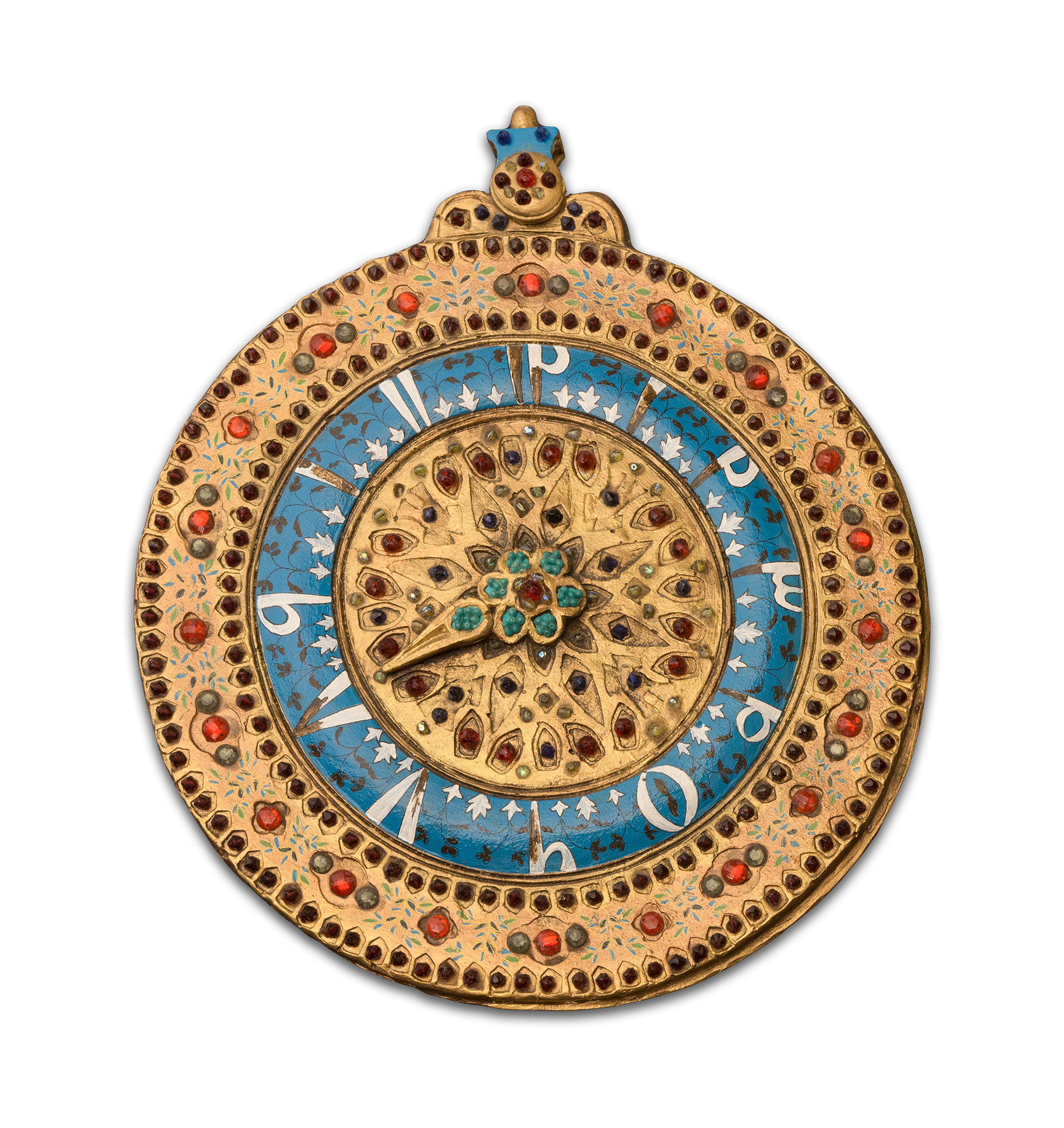
Tag
Istanbul, 1650
Location of the original clock
Topkapi Palace, Istanbul
Beginning from the time of Sultan Mehmed the Conqueror, many foreign clockmakers lived in the capitol of Ottoman Empire. In 17th Century, there were Turkish clockmakers who made clocks in Ottoman Palace and the capitol. Especially 17th Century Turkish clocks had the peak aesthetic forms in mechanical clocks with their fineness, craftsmanship, and technical foundation. The most striking aspect of these clocks was the fact that even the tiniest parts of these clocks were made by the same master. While there is no information about Turkish clockmaker Bulugat in the written resources, considering the craftsmanship and artistic value of the clock, he’s thought to have been a court clockmaker.
Source:
Sule Gurbuz, Saat Kitabi, TBMM National Palaces Publishing, Istanbul, 2011
Clock Adjustment Institute Diorama

In his book Saatleri Ayarlama Enstitusu (Clock Adjustment Institute), Ahmet Hamdi Tanpinar criticized our modernizing efforts that never lost its important in our identity problem since the time of the Reforms. Mechanical clocks as time measuring devices symbolized the effect of facing Western European technology over our social life. In his book, Tanpinar showed how the time measurement fetish among the elites proved to be discordant with the social life of Turkish people with dark humoristic examples. This diorama is an artistic work that expresses this feeling in a fantastic style. In this work, the relentless efforts of Turkish population to adjust itself to the new identity norms that came from West is explained through the clock analogy.
Alaturka/Alafranga

Mankind measured the time between the sunrise and the sunset, dividing it into 12 sun hours. Time showed the sun’s position, and the life was shaped by it. The invention of water clocks helped people to walk away from the sun, and brought the equal time system that measured the time mathematically. Jazari mostly used equal time system for his water clocks, but he adjusted them to sun time, too. Also, he developed a system that follows the changes along the year. With the invention of mechanical clocks, daily life was parted from its nature based on sun, and the time was measured in equal time system. While this transition showed itself clearly all around the world, it would take a much longer time for the people within the Ottoman borders to get used to this new understanding that was called alfranga time. The first imported European made clocks or Turkish mechanical clocks had dials with 12 needing to be readjusted to the evening prayer. With the modernizing in Ottomans, while the differences between Alaturka and Alafranga cultures created a chasm within the population, it also showed itself with a striking example with the clock analogy.
Ahmet Hamdi Tanpinar
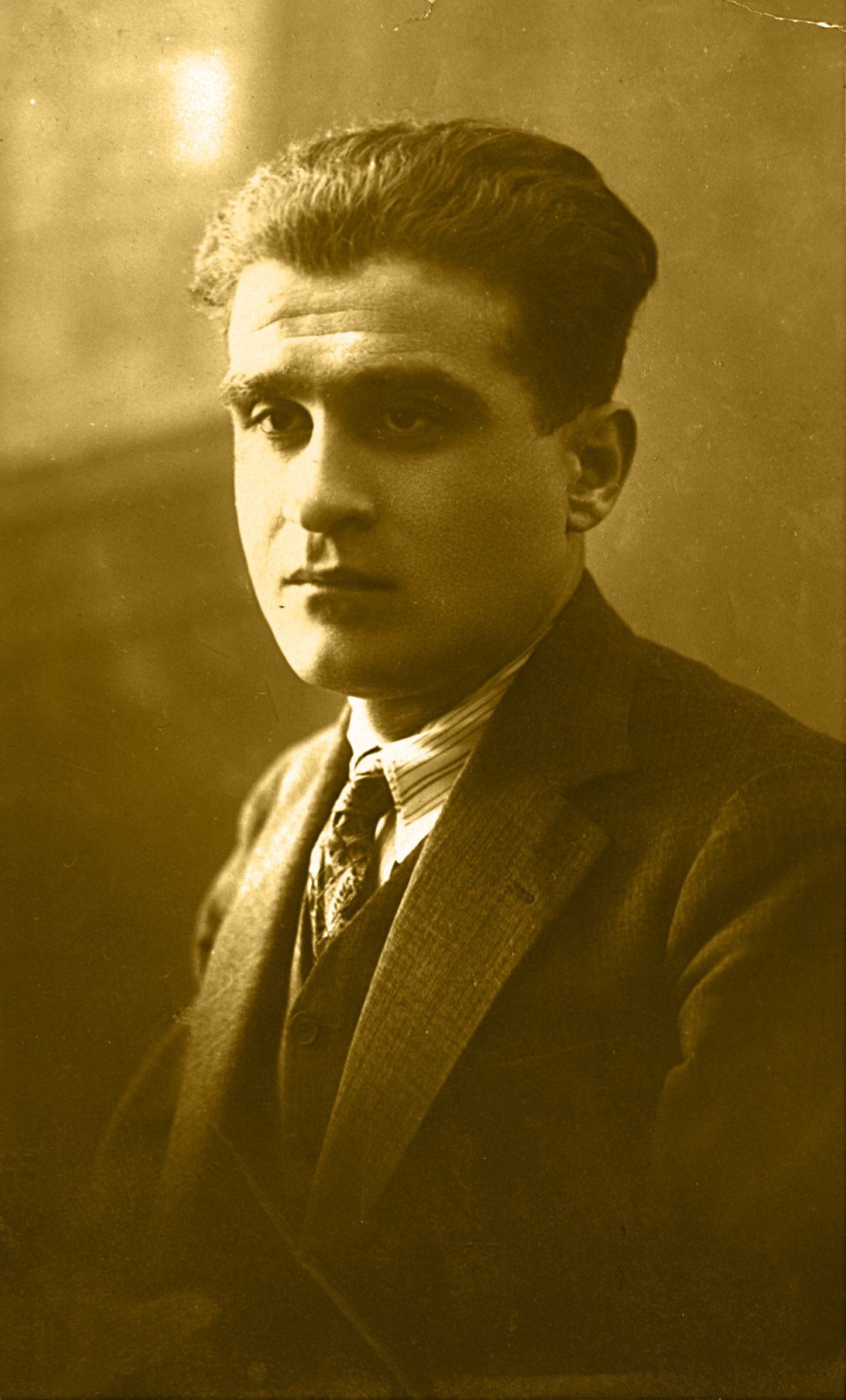
“To work, to own the time means to know how to use it. We will show how to do it. We will empower the conscience of time. I feel that you always focus on the clock, and neglect what’s beyond it. A clock is a tool. Of course, it’s an important tool. Progress begins with the evolution of the time. When the mankind began to carry their clocks in their pockets, leaving the sun behind, the civilization made the hugest leap. It left the nature behind, beginning to count the time. But that’s not enough. Clock means time, and that’s what we must take into consideration!”
Ahmet Hamdi Tanpinar, Clock Adjustment Institute
Ahmet Hasim
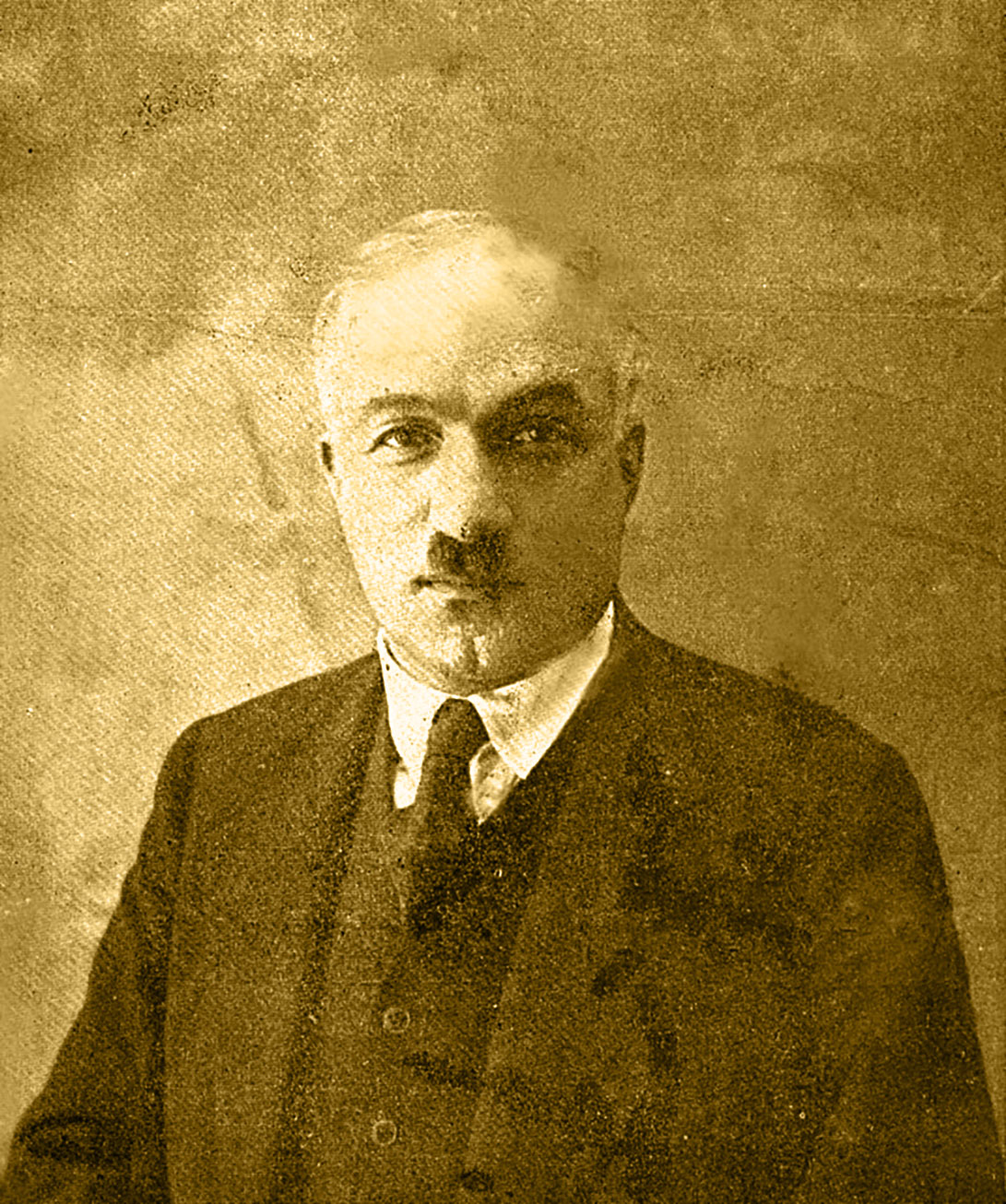
Before the use of foreign clock, we didn’t know the twenty-four hour “day” that reaches from one midnight to the next between the pitch blackness of the nights, painted in different colors of different times, red, yellow, or navy blue in these lands… A Muslim would know the beginning of the day from the first lights of the morning, and end from the darkness of night. The minute hands of those innocent clocks that were kept under the metal and solid lids move slowly, following the positions of the sky up in the heavens, walking along the numbers made of pearl, letting us know of the time approximately. Time was a limitless garden, and the clocks colorful flowers blooming in there, moving and bending here and there.
Ahmed Hashim, Islamic Clock
Sule Gurbuz
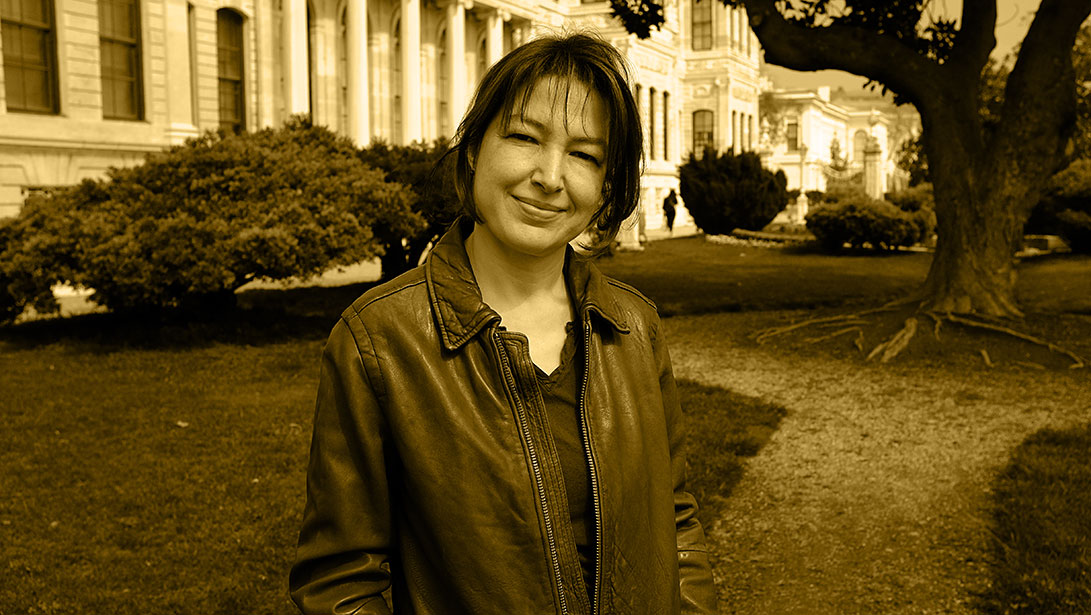
Alaturka clock and nature are in harmony in any and every way – what’s visible and what’s told are consistent. Actually this is a much finer measurement – hard looking, tough talking, proud, unchanging and unshakable with the obstinacy of an adolescence, in comparison to the maturity, wisdom, patience of the alaturka clock, which is also strong enough to live every day differently, enduring what the day brings, but also much more naïve, and vulnerable. Alafranga clock that doesn’t look up or itself to say the time always follows its own fixedness through the life.
Since the alaturka clock is decent only when readjusted, but not on itself, it’s like the sun that went home, fading its light. We can even say the alaturka clock is the shadow that casts on home from the sun above. Perhaps that’s why it looks better in shadowy houses… and shadowy, and half hearts.
Sule Gurbuz, Alaturka Saat Alaturka Zaman
Steam Engine
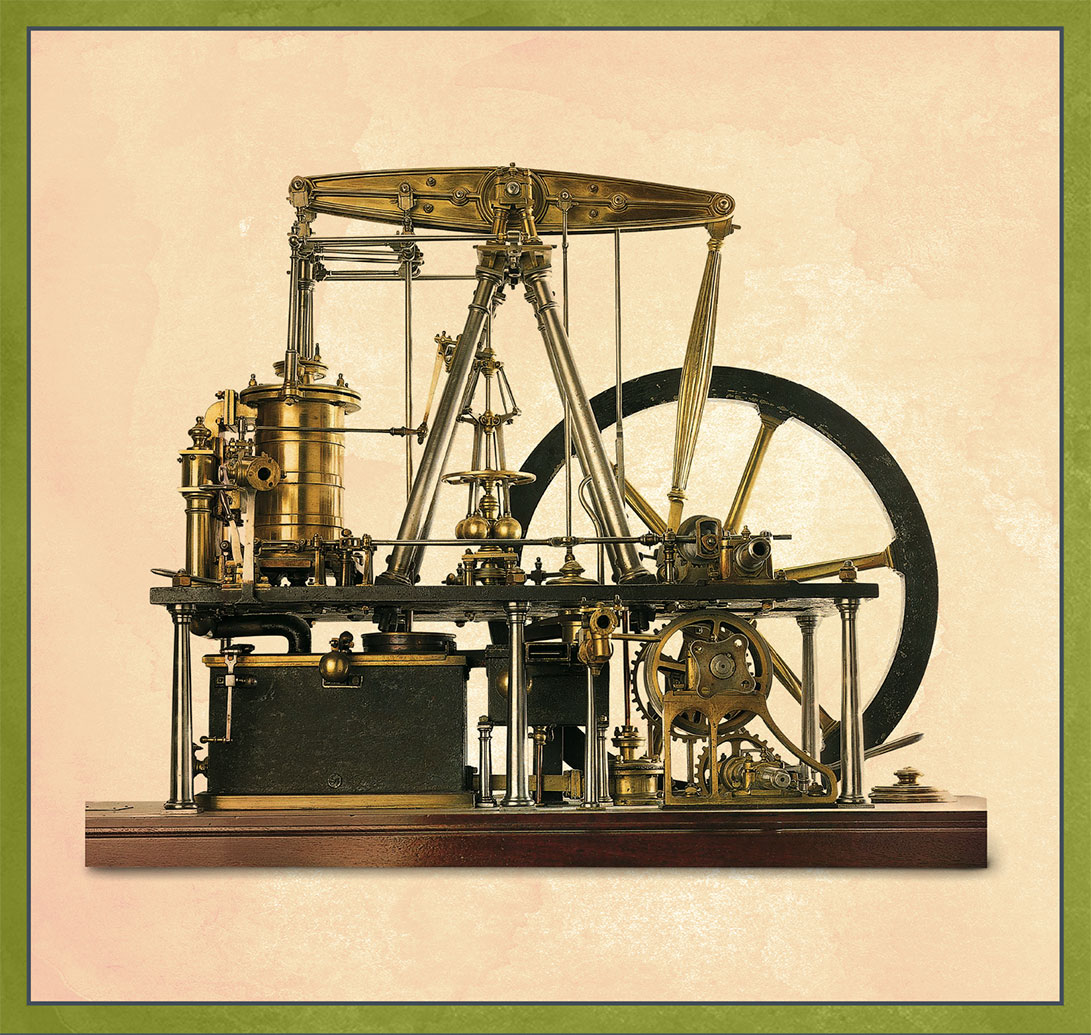
The Cauldron in Which the Industrial Revolution Boiled: Steam Engine
Steam engine is a machine that transforms the thermal energy of steam to moving energy. Steam engine was the main power source of the Industrial Revolution in Europe during eighteenth and nineteenth centuries.
The first steam engine was made by English engineer Thomas Savery in 1698. This machine was made to pump the water out of coal mines. As a matter of fact, when the water is boiled inside this machine, which was simply a boiler, it’s drained out by a pipe. When the entire water is vaporized, the exit valve is shut down, and with the vacuum created inside, water is sucked through another pipe. And this water is drained out again through vaporizing. A few years later, another English engineer named Thomas Newcomen added a cylinder and piston into this boiler, and turned it to a steam pump. However, the most important improvement to the steam machine came by Scottish engineer James Watt in 1769. If the steam was condensed apart from the cylinder, it could always remain hot. Watt designed another steam engine that year with a separate condenser and watertight cylinders.

15 years later, Watt made three more important additions to his machine:
1. He developed a regulator that could control the steam flow and engine speed (governor).
2. Allowing the steam in through both sides of the cylinder, he developed double action engine, which made it possible a piston apply force from both sides.
3. Most importantly, he connected a flywheel to the engine.
Flywheels made the engine more stable, and transformed the traditional back and forth movement to a circular movement that could adapt it to the power machine. When it was 1790, Watt’s steam engine became a reliable and powerful energy source that could be purchased anywhere.
Governor System

Governor is a feedback system developed for a fixed rotation for a steam engine, and it adjusts the steam that flows to the piston according to the engine’s rotation.
Steam that comes from the boiler moves through a valve before reaching the pistons.
- The piston that moves back and forth with the steam power turns to a circular movement by the crankshaft.
- To adjust this rotation at a fixed or desired speed, the system that appears like it has two balls connected to its end and positioned perpendicular to the shaft called Governor and the little gears rotates.
- Due to the centrifugal force that is created by the rotation of the balls, the arms open, and the angles change based on the rotation speed.
- The frontal valve that is connected to these arms opens and closes based on the rotation speed.
- Thus, a fixed speed is established by adjusting the amount of steam that goes into the piston.
